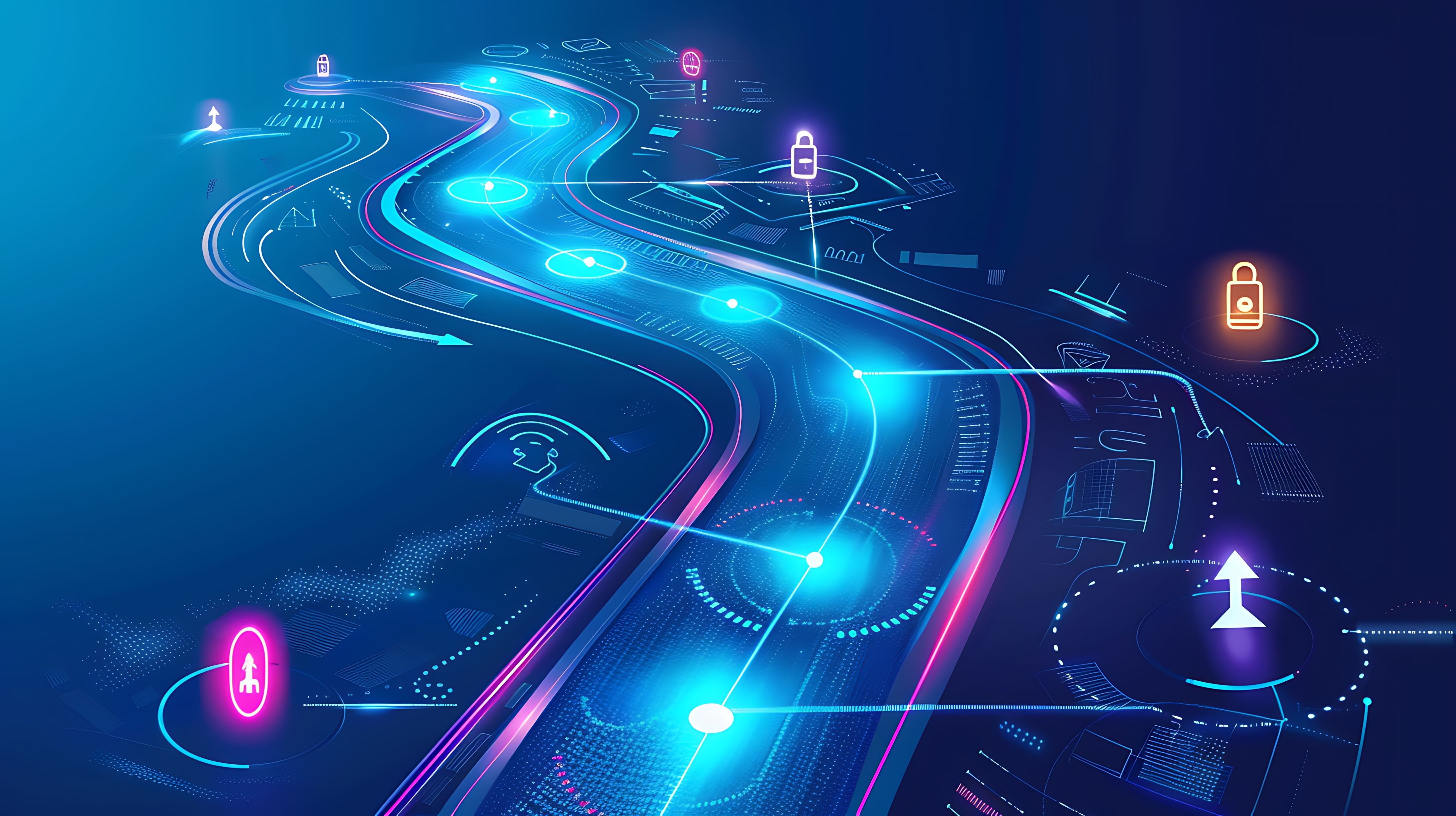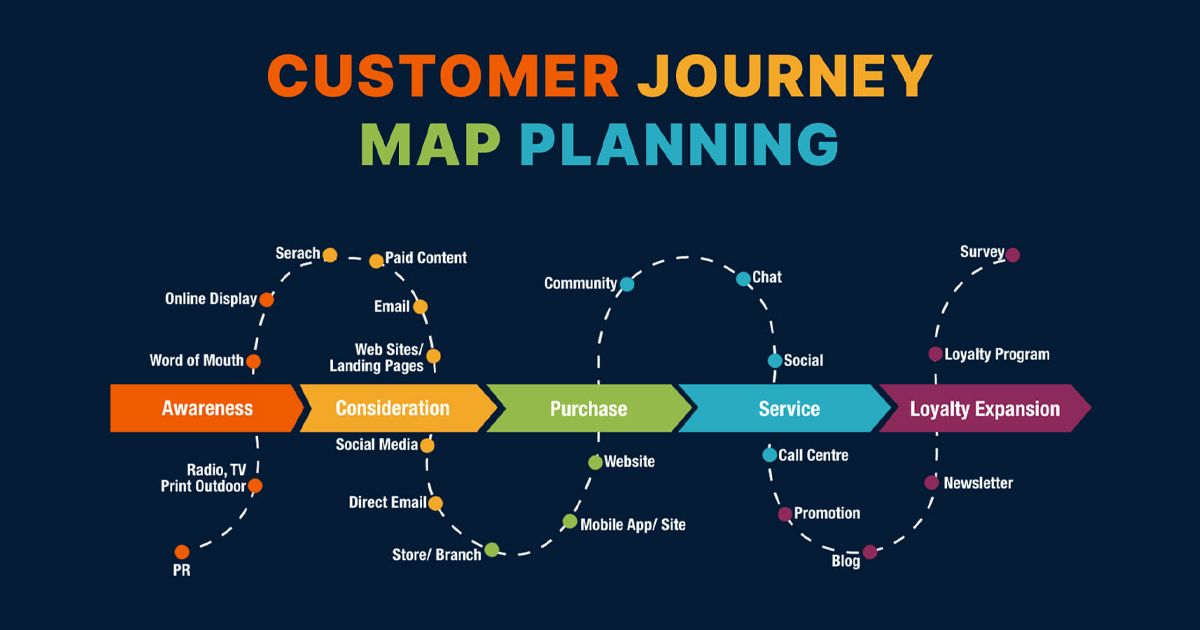What is Customer Journey?

The Customer Journey is the process customers go through from the awareness stage of a product or service to becoming a buyer and eventually a loyal brand advocate. It’s a series of interactions and touchpoints that customers experience when engaging with a brand, from the initial contact to the purchase and beyond. Building a clear customer journey allows businesses to control and optimize each touchpoint, rather than letting things unfold naturally.
The importance and benefits of understanding the Customer Journey
Understanding the Customer Journey is crucial for optimizing customer experience and improving business performance. When businesses grasp the entire customer journey from the early stages to post-purchase, they can enhance each interaction, creating positive and seamless experiences. This not only boosts customer satisfaction and retention but also optimizes marketing strategies, improves conversion rates, and saves budget.

In practice, the customer journey not only highlights the importance of understanding the customer path but also emphasizes that it can bring substantial benefits in terms of business efficiency and cost savings for brand growth:
- Increased conversion rates: According to a report by HubSpot, businesses with a clear Customer Journey strategy can see conversion rates up to 70% higher than those without such a strategy.
- Enhanced customer experience: McKinsey & Company notes that companies investing in customer experience improvement can witness a 20% increase in customer satisfaction and a 15% increase in revenue.
- Boosted marketing efficiency: A Forrester study found that businesses utilizing Customer Journey analytics can enhance marketing efficiency and reduce marketing costs by up to 30%.
- Improved customer retention: Research from Salesforce shows that companies focusing on understanding and managing the Customer Journey are 25% more likely to retain customers compared to competitors who don’t.
- Creating exceptional value: According to reports from Deloitte, 60% of customers are willing to pay an additional 10-15% for products or services from a brand with a positive experience.
These figures not only underscore the importance of understanding the customer journey but also demonstrate that doing so can lead to significant business efficiency and cost-saving advantages.
Stages of the Customer Journey
To fully grasp how customers interact with and experience a brand, analyzing the stages of the Customer Journey is essential. The Customer Journey consists of a series of steps that customers go through from their first brand encounter to becoming loyal customers. Each stage of this journey presents unique opportunities and challenges, requiring businesses to effectively understand and manage them to optimize the customer experience and drive conversion.

Exploring these stages not only helps businesses better understand the customer journey but also provides valuable insights to develop optimal marketing and service strategies. The stages of the customer journey include:
Stage 1: Awareness
Stage 2: Consideration
Stage 3: Conversion (Purchase Decision)
Stage 4: Retention
Stage 5: Loyalty
Stage 1: Product/Service Awareness
The awareness stage is a crucial starting point in the Customer Journey, where customers first come into contact with a brand, product, or service. This is when customers recognize a problem or need and begin seeking solutions. At this stage, a business's goal is to create brand recognition and attract the attention of potential customers.
During the awareness stage, using a diverse range of advertising channels helps businesses expand their reach and make a strong impression on potential customers. Below are the key advertising channels businesses can utilize:
- Social media: With its wide usage and growing reach, social media platforms play an essential role in broad promotion and direct interaction, allowing businesses to use images and video ads to introduce products.
- Company website: A highly effective channel where businesses can use banner ads, images, videos, and SEO articles to enhance their online presence and attract customers.
- Events: No matter the industry, be it product or service-based, exhibitions and trade shows provide opportunities for businesses to directly introduce products to the public while building closer relationships with customers.
- PR on newspapers and magazines: Through this method, businesses can reach a large readership through articles and banner ads, raising brand awareness in the industry.
- Email marketing: Particularly important in B2B enterprises, email marketing allows businesses to send product, solution, and service information to a targeted customer list.
Effective use of these advertising channels not only helps businesses build brand recognition and increase their ability to reach target audiences, but also broadens their influence and creates a positive impression from the earliest stages of the customer journey. Attracting potential customers during the awareness stage requires crafting an engaging advertising message to capture their attention. Additionally, accurately identifying the target customer persona helps optimize advertising campaigns, ensuring the message reaches the right audience and generates maximum effectiveness at a reasonable cost.
Stage 2: Consideration
The consideration stage follows after customers become aware of a business’s product or service. At this stage, potential customers begin comparing and evaluating different options to decide which solution best meets their needs. This is a crucial time for businesses to provide additional information and create value to encourage customers to move from awareness to the decision stage.
To optimize marketing strategies during this phase, businesses can implement the following approaches:
- Launch time-limited promotions to create a sense of urgency (FOMO) for first-time buyers.
- Establish direct interaction through calls, messages, or meetings to build trust and quickly address customer inquiries.
- Offer testimonials from past customers and successful case studies. According to a report from Dixa, 79% of customers value reviews from previous buyers, and positive reviews can boost revenue by up to 18%. Highlighting these positive reviews not only enhances credibility but also helps new customers make purchasing decisions more easily.
The consideration stage offers businesses a chance to not only provide valuable information but also build trust and solidify why their product or service is the best choice. Focusing on creating value and providing attentive support can increase conversion rates and encourage customers to move to the decision stage.
Stage 3: Conversion (Purchase Decision)
The decision stage is the moment when customers are ready to make a purchase or use a service. To optimize conversion rates and ensure customers complete their transactions, businesses can apply the following strategies:
- Optimize the e-commerce site: Design user-friendly, easy-to-navigate websites or apps to create a seamless shopping experience. Enhancing UI can significantly improve conversion rates.
- Streamline the sales and payment process: Simplifying and reducing unnecessary steps and information requests can make the payment process more fluid, minimizing cart abandonment rates.
- Provide special offers and discounts: Offering exclusive deals such as discounts, free gifts, or free shipping can encourage customers to complete their purchases immediately. This is an effective way to drive action before customers leave the website.
- Personalized support and advice: Provide support via live chat, calls, or emails to answer any final questions and guide customers through their decision process. Timely and effective support can make customers feel valued and encourage them to complete the transaction.
The decision stage is an important opportunity to ensure customers finalize their purchase and to build long-term relationships. By applying these strategies, businesses can optimize customer experiences and achieve higher conversion rates.
Stage 4: Retention
The retention stage is a crucial part of the customer journey, where businesses focus on retaining current customers and building long-term relationships. According to a Harvard Business study, increasing customer retention rates by just 5% can boost profits by 25% to 95%, while saving 30% to 50% on marketing costs compared to acquiring new customers. These figures emphasize the importance of retaining existing customers and demonstrate that investing in retention strategies can yield significant financial and marketing benefits.
To increase customer retention while saving costs, businesses should ensure the following activities in their customer journey:
- Deliver exceptional customer experiences: Stand out by providing exceptional customer experiences through user-friendly interfaces, quick and excellent support services, and more. These interactions help deliver personalized and standout experiences for each customer, making the brand more memorable.
- Offer strong after-sales services: Essential services like warranties, repairs, upgrades, and customer support build trust and satisfaction. These activities ensure the brand remains "top of mind" when customers need assistance.
- Develop loyalty programs: Implement loyalty programs such as points accumulation, exclusive offers, and special promotions to make customers feel valued and encourage them to continue engaging with the brand.
- Send updates and new product information: Use communication channels like social media and email to periodically send useful information and product updates, keeping customers engaged and maintaining their interest.
Stage 5: Loyalty
The loyalty stage is the final phase of the customer journey, and it is the stage every business aspires for its customers to reach. Once customers have purchased products or used services and become loyal patrons, businesses can build a sustainable customer base by implementing the following activities:
- Build a customer community: Loyal customers should have the opportunity to join a community where they can exchange, interact, and share experiences about products or services. According to a Nielsen study, 92% of consumers trust recommendations from friends and family over traditional advertisements, highlighting the importance of creating a community and encouraging positive discussions about the brand.
- Leverage referral marketing: Businesses can harness the support of current customers by encouraging them to refer products or services to others. Referral marketing not only enhances trust but also expands the customer base through positive word-of-mouth recommendations. According to a study by ReferralCandy, referral programs can boost revenue by up to 25%.
- Offer special policies for loyal customers: Provide exclusive policies and services for loyal customers to show appreciation and respect. For example, businesses can offer personalized products (such as customizing products with the customer’s name), special gifts, discounts, or exclusive promotions during significant occasions like birthdays or holidays.
Building a detailed and comprehensive customer journey allows businesses to plan effective business and marketing strategies. Gaining deeper insights into customers helps businesses optimize strategies and save costs, thereby improving the overall efficiency of business operations.
Conclusion
The customer journey emphasizes the importance of optimizing every touchpoint along the journey to create a seamless and consistent experience for customers. Analyzing and understanding each stage, from awareness to consideration, decision, and post-purchase care, not only helps businesses attract potential customers but also fosters long-term loyalty. The combination of qualitative and quantitative data plays a critical role in personalizing experiences, optimizing conversion rates, and increasing customer satisfaction. In today’s highly competitive environment, effectively managing the customer journey will be a key factor in helping businesses increase value and maintain a competitive edge in the market.
Salesforce
Salesforce CRM is one of the world’s leading customer relationship management platforms, widely used by organizations large and small worldwide. With its flexible features and applications, Salesforce helps businesses strengthen customer relationships, optimize the sales process, and increase revenue by providing powerful information and management tools.
The standout features of Salesforce software that support efficient business management include: marketing management; customer relationship management; sales management; and integration with other applications and systems.




